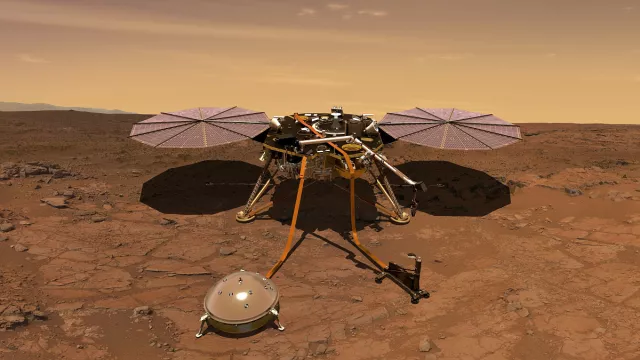InSight (INterior exploration using Seismic Investigations, Geodesy and Heat Transport) est une mission de géophysique du Programme Discovery de la NASA. Cet atterrisseur s'est posé sur Mars afin d’étudier sa structure interne. Objectif : mieux comprendre comment se forment les planètes rocheuses.
Le CNES participe à la mission avec la supervision du développement du sismomètre SEIS, puis les opérations de SEIS et de la station météorologique APSS.
Key information
Key figures
- 5 instruments on lander
- 3 kg: mass of SEIS instrument
- 29 Gb of data from InSight
- 358 kg: lander mass
Key milestones
- 2023-2025: Teams on standby listening to see if InSight wakes up on the surface of Mars, mission centre active until end 2025. Science data analysis phase.
- 21 December 2022: End of InSight mission operations
- January 2021: Expected end of SEIS nominal mission
- Start February 2019: SEIS instrument starts operating
- 26 November 2018: InSight lands on surface of Mars
- 5 May 2018: SEIS instrument launched with InSight by Atlas V
- 18 July 2017: Flight model of SEIS instrument delivered to JPL
- 5 March 2015: Choice of landing site validated
- 16 May 2014: Development work starts on SEIS instrument
- 11 February 2014: CNES decides to take part in NASA’s InSight mission
- 2012: NASA selects InSight mission for its Discovery Program
Project in brief
InSight aimed to study Mars’ deep interior structure using a geophysical station deployed from a fixed lander to better understand the mechanisms that shaped the rocky planets in our solar system. Using the SEIS seismometer (Seismic Experiment for Interior Structures), it measured Mars’ tectonic activity to learn more about its structure, for example the size of its core and the thickness of its mantle. Meteorite impacts were also analysed by measuring seismic waves. The Heat Flow and Physical Properties Package (HP3) gauged the planet’s cooling rate in order to retrace its thermal history. And the RISE instrument (Rotation and Interior Structure Experiment) acquired precise measurements of the Red Planet’s rotation.
InSight landed on Mars on 26 November 2018 for a nominal two-year mission, subsequently extended a further two years.
The mission’s SEIS seismometer detected a “marsquake” for the first time ever on 7 April 2019.
CNES’s role
CNES oversaw development of the SEIS instrument in partnership with the IPGP Earth physics institute in Paris, SODERN (EADS Group), the Swiss Federal Institute of Technology (ETH), the Max Planck Institute for Solar System Research (MPS), Imperial College London and the Jet Propulsion Laboratory (JPL). InSight is the 12th mission of NASA’s Discovery Program.
Contacts
SEIS Operations Project Leader for InSight
Charles Yana
E-mail: charles.yana at cnes.fr
SEIS-InSight Systems Engineer
Ludovic Rochas
E-mail: ludovic.rochas at cnes.fr
Ground Support Operations Manager
Christophe Ferrier
E-mail: christophe.ferrier at cnes.fr
InSight Programme Manager, Solar System and Planets and Small Bodies subject matter expert
Francis Rocard
E-mail: francis.rocard at cnes.fr


